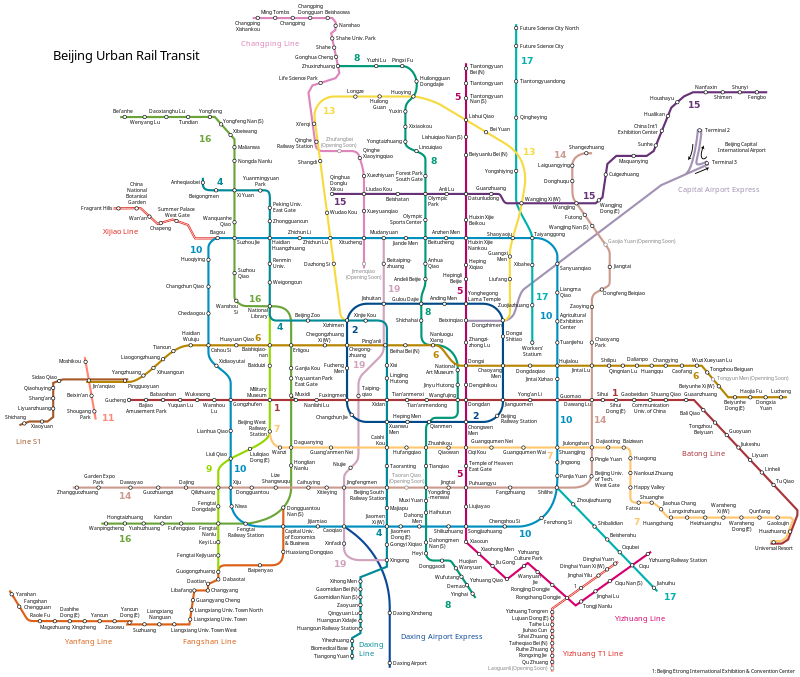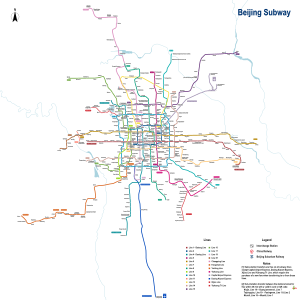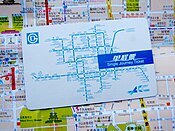
A | B | C | D | E | F | G | H | CH | I | J | K | L | M | N | O | P | Q | R | S | T | U | V | W | X | Y | Z | 0 | 1 | 2 | 3 | 4 | 5 | 6 | 7 | 8 | 9
| Beijing Subway | |||||||
|---|---|---|---|---|---|---|---|
 Logo of Beijing Subway | |||||||
 A line 13 train leaving Huoying station | |||||||
| Overview | |||||||
| Native name | |||||||
| Chinese name | |||||||
| Simplified Chinese | 北京地铁 | ||||||
| Traditional Chinese | 北京地鐵 | ||||||
| |||||||
| Owner | Beijing Municipal Government | ||||||
| Locale | Beijing & Langfang, Hebei | ||||||
| Transit type | Rapid transit | ||||||
| Number of lines | 27 | ||||||
| Number of stations | 490[1] | ||||||
| Daily ridership | 10.544 million (2018 daily avg.)[2] 13.7538 million (12 July 2019 record)[3] | ||||||
| Annual ridership | 3.8484 billion (2018)[2] | ||||||
| Website | bjsubway.com mtr.bj.cn bjmoa.cn | ||||||
| Operation | |||||||
| Began operation | 15 January 1971 | ||||||
| Operator(s) |
| ||||||
| Character | Underground, at grade and elevated | ||||||
| Number of vehicles | 6,173 Revenue Railcars (2019)[4] | ||||||
| Technical | |||||||
| System length | 836 km (519 mi)[1] | ||||||
| Track gauge | 1,435 mm (4 ft 8+1⁄2 in) standard gauge | ||||||
| Electrification |
| ||||||
| |||||||
The Beijing Subway is the rapid transit system of Beijing Municipality that consists of 27 lines including 22 rapid transit lines, two airport rail links, one maglev line and 2 light rail lines, and 490 stations.[1] The rail network extends 836 km (519 mi)[1] across 12 urban and suburban districts of Beijing and into one district of Langfang in neighboring Hebei province. With 3.8484 billion trips delivered in 2018,[2] an average of 10.544 million trips per day,[2] the Beijing Subway is the world's busiest metro system. Single-day ridership set a record of 13.7538 million on July 12, 2019.[3] Being 836 kilometres (519 mi) in system length, the Beijing Subway is the longest metro system by route length, surpassing the Shanghai Metro in December 2023.
The Beijing Subway opened in 1971 and is the oldest metro system in mainland China and on the mainland of East Asia. Before the system began its rapid expansion in 2002, the subway had only two lines. The existing network still cannot adequately meet the city's mass transit needs. Beijing Subway's extensive expansion plans call for 998.5 km (620.4 mi)[5] of lines serving a projected 18.5 million trips every day when Phase 2 Construction Plan finished (around 2025).[6][7][8] The most recent expansion came into effect on December 30, 2023, with the openings of extensions to Line 11, Line 16, and Line 17.
Fares
Fare schedules
Single-ride fare
The Beijing Subway charges single-ride fare according to trip distance for all lines except the two airport express lines.
- For all lines except the two airport express lines, fares start at ¥3 for a trip up to 6 km in distance, with ¥1 added for the next 6 km, for every 10 km thereafter until the trip distance reaches 32 km, and for every 20 km beyond the first 32 km.[9] A 40 km trip would cost ¥7.
- The Capital Airport Express has a fixed fare of ¥25 per ride.[10]
- The Daxing Airport Express is the only line to maintain class-based fares with ordinary class fare varying with distance from ¥10 to ¥35 and business class fare fixed at ¥50 per ride.[11]
Same-station transfers are free on all subway lines except the two Airport Express lines, the Xijiao Line and the Yizhuang T1 Line, which require the purchase of a new fare when transferring to or from those lines.
Fare free riders
Children below 1.3 metres (51 in) in height ride for free when accompanied by a paying adult.[12] Senior citizens over the age of 65, individuals with physical disabilities, retired revolutionary cadres, police and army veterans who had been wounded in action, military personnel and People's Armed Police can ride the subway for free.[13]
Unlimited-rides fare
Since January 20, 2019, riders can purchase unlimited rides fare tickets using the Yitongxing (亿通行) APP on smartphones, which generates a QR code with effective periods of one to seven days.
| Fare | Trip distance |
|---|---|
| ¥3 | <6 km |
| ¥4 | 6–12 km |
| ¥5 | 12–22 km |
| ¥6 | 22–32 km |
| ¥7 | 32–52 km |
| ¥8 | 52–72 km |
| ¥9 | 72–92 km |
| ¥10 | 92–112 km |
| Period | Price |
|---|---|
| 1 day | ¥20 |
| 2 days | ¥30 |
| 3 days | ¥40 |
| 5 days | ¥70 |
| 7 days | ¥90 |
Previous fare schedules
On December 28, 2014, the Beijing Subway switched from a fixed-fare schedule to the current distance-based fare schedule for all lines except the Capital Airport Express.[9][11] Prior to the December 28, 2014 fare increase, passengers paid a flat rate of RMB(¥) 2.00 (including unlimited fare-free transfers) for all lines except the Capital Airport Express, which cost ¥25,[14] The flat fare was the lowest among metro systems in China.[15] Before the flat fare schedule was introduced on October 7, 2007, fares ranged from ¥3 to ¥7, depending on the line and number of transfers.
Fare collection
Each station has two to fifteen ticket vending machines.[16] Ticket vending machines on all lines can add credit to Yikatong cards.[17] Single-ride tickets take the form of an RFID-enabled flexible plastic card.
| Discounts for Yikatong card users | ||
|---|---|---|
| Monthly expenditure |
Net expenditure after credit rebate |
Net discount |
| ¥50 | ¥50 | 0% |
| ¥100 | ¥100 | 0% |
| ¥150 | ¥140 | 6.67% |
| ¥200 | ¥165 | 17.5% |
| ¥250 | ¥190 | 24% |
| ¥300 | ¥215 | 28.3% |
| ¥350 | ¥240 | 31.4% |
| ¥400 | ¥265 | 33.75% |
| ¥450 | ¥315 | 30% |
| ¥500 | ¥365 | 27% |
Passengers must insert the ticket or scan the card at the gate both before entering and exiting the station. The subway's fare collection gates accept single-ride tickets and the Yikatong fare card. Passengers can purchase tickets and add credit to Yikatong card at ticket counters or vending machines in every station. The Yikatong, also known as Beijing Municipal Administration & Communication Card (BMAC), is an integrated circuit card that stores credit for the subway, urban and suburban buses and e-money for other purchases.[18] The Yikatong card itself must be purchased at the ticket counter. To enter a station, the Yikatong card must have a minimum balance of ¥3.00.[19] Upon exiting the system, single-ride tickets are inserted into the turnstile, which are reused by the system.
To prevent fraud, passengers are required to complete their journeys within four hours upon entering the subway.[13] If the four-hour limit is exceeded, a surcharge of ¥3 is imposed.[20] Each Yikatong card is allowed to be overdrawn once. The overdrawn amount is deducted when credits are added to the card.[21]
Yikatong card users who spend more than ¥100 on subway fare in a calendar month will receive credits to their card the following month.[9] After reaching ¥100 of spending in one calendar month, 20% of any further spending up to ¥150 will be credited. When spending exceeds ¥150, 50% of any further spending up to ¥250 will be credited.[9] Once expenditures exceed ¥400, further spending won't earn any more credits.[9] The credits are designed to ease commuters' burdens of fare increases.[9]
Beginning in June 2017, single-journey tickets could be purchased via a phone app.[22] A May 2018 upgrade allowed entrance via scanning a QR code from the same app.[23]
Since the COVID-19 pandemic, a name and Chinese Resident Identity Card number must be entered when buying single-ride tickets for contact tracing purposes. This measure has been criticized for increasing the time spent buying tickets.[24]
Lines in operation
Beijing Subway lines generally follow the checkerboard layout of the city. Most lines through the urban core (outlined by the Line 10 loop) run parallel or perpendicular to each other and intersect at right angles.





